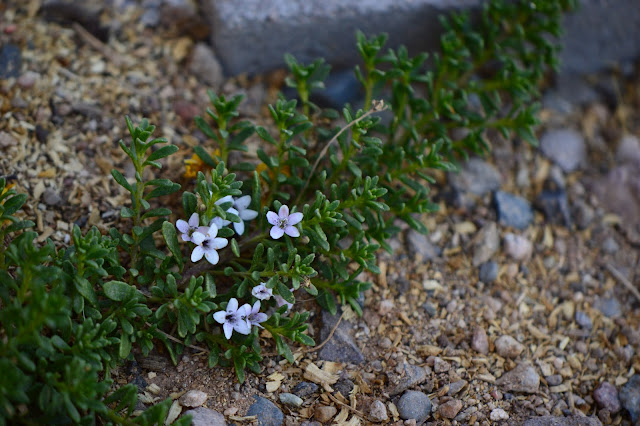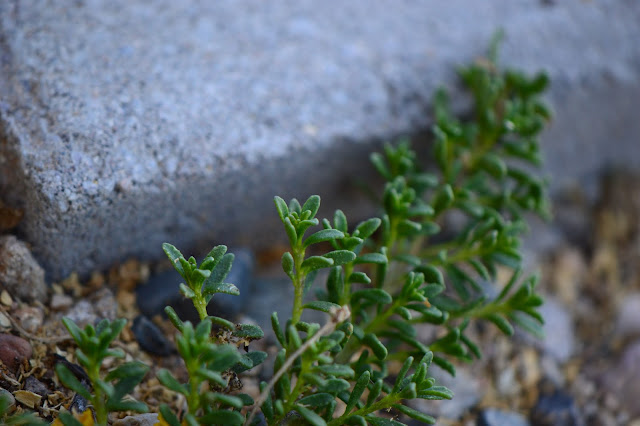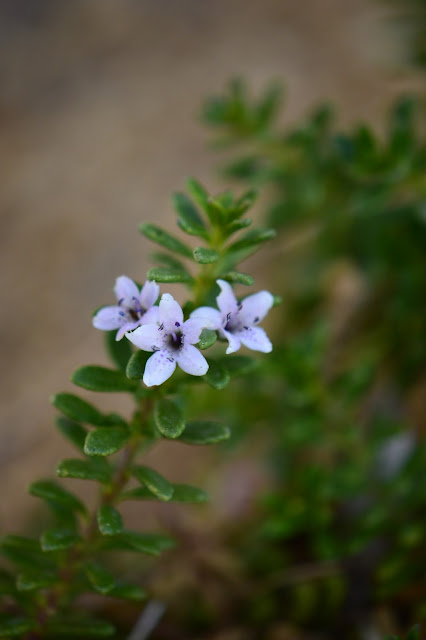Myoporum parvifolium "Prostratum" is my attempt to find a solution to a very knotty problem: I need/want low-growing green in my garden paths. By all accounts it is difficult to find plants which will work for the purpose in this region. Most are expected to burn out (rather literally) within a few years.
I had intended to use some type of creeping thyme. But it has been a little hard to locate (itself a warning sign), and I simply don't find it recommended by area gardeners. English thyme, grown as a herb, yes, but the Thymus serpyllum varieties for use as a thyme lawn, no.
The obvious alternative, and the solution most frequently used here for any purpose, is to fill in with gravel or rock. But with two acres worth of mostly-bare dirt, I did want a patch of green underfoot in the garden.
So I have finally decided to try a plant whose reputation varies from well-behaved to take-over. In favor of the chances of it remaining a tame plant, it will receive minimal watering -- another priority which determined my choice as I don't care to spend a lot of water on the paths. It is stem-rooting in moist soil, which may cause difficulties once it reaches the borders. However, if it begins to invade them, I shall simply have to pull it out! I am growing very tired of weedy dirt patches to walk along!
I planted just one to give it a try. After a few weeks of looking a bit sorry for itself, it seemed to take hold and has begun to fill out into a low clump. Here it is...
 |
| Please pardon the low light on these photos! |
It has small leaves of a nice, quiet shade of green and a very low-growing, compact habit -- at least so far!
And it blooms. While the usual color is white, this one was labelled as "Pink", but the color is not really so strong as all that! My camera was struggling with too much shade, so the photo looks much bluer than it should. In reality the hue is a very pale pink.
I'm not holding my breath on this one. If it works, well and good. If it doesn't, it will be time for a plan overhaul. Right now, I am happy with the plant and, of course, hoping I have found a way to go on with my original idea of green paths interspersed with pavers. But it's too early to tell how this will turn out...





I hope the Myoporum works for you, Amy. I've used it in my dry garden and, after 3 years, I'd say it's manageable here. That's not to say it doesn't grow fast - it does. But it stretches out in long rope-like stems that are easy to cut back if they get out of line. If Thymus serpyllum is unavailable in your area, you might want to see if woolly thyme, T. pseudolanuginosus, is. I've used that one extensively too. It also creeps but my sense is that it's the more drought and heat tolerant of the two species, as evidenced by its tiny, hairy gray leaves.
ReplyDeleteThat description sounds like what I was hoping for, Kris! I was worried it would sneak around and make an absolute mess ;-) I'll definitely look out for woolly thyme too - thanks for the info!
DeleteThis looks like a lovely plant! I love the tiny glossy leaves and the little flowers are a bonus. I really hope it works for you as it seems as if it could be a great choice. I know that sometimes plants come with a warning about taking over but I often don't pay attention - I think if you enjoy being out in the garden its easy to keep plants in bounds by a little pulling and trimming - I always think its the self seeders that are the problem. Hope you are happy with the choice!
ReplyDelete- Kate x
I think it's really quite attractive, and I'm hoping it will stay so! I agree about self-seeders though I do worry about roots that sneak around, remembering my battle with wisteria in Kansas City. When I planted it, I had no idea that a little further south and east it was known for taking over entire farms! At any rate, I don't think Myoporum looks like that kind of hazard!
DeleteHi Amy, thanks for your nice comment on my lilac vase which I just retrieved from my spam. This little creeper looks sweet but I suppose it may not be that hardy (will investigate). Bet your climate is quite challenging. How does one choose the desert? I'm curious and will pop back for more :), Annette from Annette's Garden (very difficult to comment on your blog, had to try many times)
ReplyDeleteThanks so much for checking your spam bin ;-) I'm sorry you had so much trouble with commenting; occasionally that happens, but I don't know why. I'll check my settings!
DeleteI find that this plant is considered hardy to -5 C in this area, which should be enough in my current garden though one never knows...! There are certainly many difficulties gardening here, but the challenge is exciting, and the beauty of the desert makes it well worth while - for me, at any rate! I have always loved being in the desert, so I was delighted at the opportunity to live here.